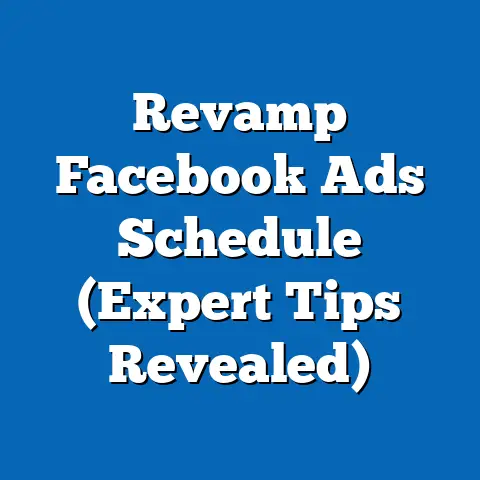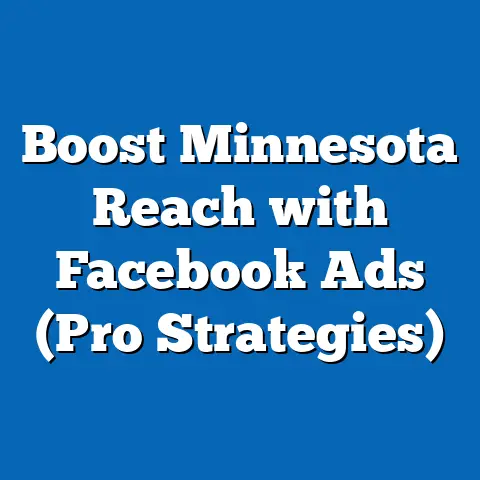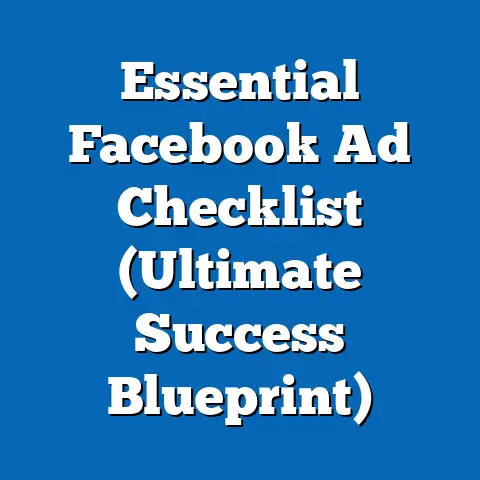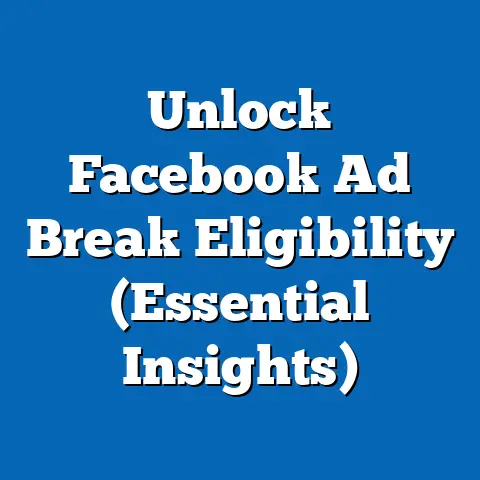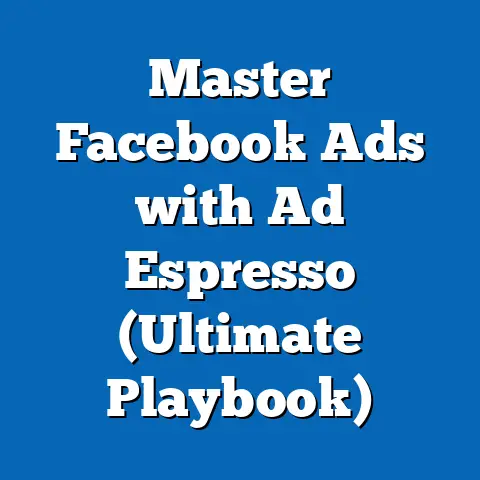Master the Facebook Link Ad Format (Ultimate Guide)
When it comes to discovering new flavors, do you prefer the excitement of a tantalizing dish that you can’t wait to try, or the comfort of a tried-and-true favorite? I’ve always been drawn to the new and exciting, especially when it comes to food. It’s the same with advertising – sometimes you want to stick with what you know, but other times, you need to explore new avenues to truly satisfy your audience’s appetite.
Just like our diverse food preferences, our digital advertising preferences vary greatly. Some marketers swear by video ads, others love carousel ads, but for me, the Facebook link ad has always been a dependable workhorse. It’s like that classic burger – simple, effective, and when done right, incredibly satisfying.
The Facebook link ad is more than just a way to drive traffic to your website. It’s a powerful tool for generating leads, increasing brand awareness, and ultimately, growing your business. But like any good recipe, it requires the right ingredients and a bit of finesse to truly master.
In this ultimate guide, I’m going to walk you through everything you need to know about Facebook link ads. I’ll share my personal experiences, insights, and best practices to help you create link ads that not only grab attention but also deliver real results. Get ready to refine your taste and master the art of Facebook link ads!
Section 1: Understanding Facebook Link Ads
Before we dive into the nitty-gritty, let’s lay the foundation with a solid understanding of what Facebook link ads are and how they fit into the broader advertising landscape.
Definition of Facebook Link Ads
At its core, a Facebook link ad is an advertisement designed to drive traffic from Facebook to an external website or landing page. It’s a simple yet effective format that includes a headline, ad copy, a visual (image or video), and a call-to-action button. When a user clicks on the ad, they are directed to the specified URL.
Think of it as a digital billboard. You have a limited amount of space and time to capture someone’s attention and entice them to learn more. The key is to make that brief interaction count.
I remember when I first started using Facebook link ads, I treated them like glorified banner ads. I threw up a product image, slapped on a generic headline, and hoped for the best. Needless to say, my results were underwhelming. It wasn’t until I started understanding the nuances of each element – the power of compelling copy, the impact of eye-catching visuals, and the importance of a clear call to action – that I started seeing real success.
The benefits of using Facebook link ads are numerous:
- Driving Traffic: The most obvious benefit is the ability to send targeted traffic directly to your website. This is crucial for businesses looking to increase website visits, generate leads, or drive sales.
- Generating Leads: By directing users to a specific landing page, you can capture valuable lead information through forms or opt-ins.
- Increasing Brand Awareness: Even if users don’t immediately click on your ad, a well-crafted link ad can still leave a lasting impression and increase brand recognition.
- Cost-Effective Advertising: Compared to other ad formats, link ads can be relatively cost-effective, especially when targeted effectively.
How Link Ads Fit into Facebook’s Ad Ecosystem
Facebook offers a variety of ad formats, each with its own strengths and weaknesses. Link ads are just one piece of the puzzle. Understanding how they compare to other formats can help you choose the right tool for the job.
- Image Ads: Simple and straightforward, image ads are great for showcasing products or services with a single, compelling image. However, they lack the direct call-to-action of a link ad.
- Video Ads: Highly engaging, video ads can tell a story and capture attention more effectively than static images. However, they can be more expensive to produce and require a strong hook to keep viewers engaged.
- Carousel Ads: Allow you to showcase multiple images or videos in a single ad unit. This is great for highlighting different features of a product or telling a sequential story.
- Collection Ads: Designed for e-commerce, collection ads showcase a catalog of products in a visually appealing format.
- Lead Ads: Specifically designed to capture lead information directly within Facebook, without sending users to an external website.
Link ads stand out because they offer a direct path to your website or landing page. They are ideal for campaigns focused on:
- Driving Website Traffic: If your primary goal is to increase website visits, link ads are the way to go.
- Promoting Blog Content: Link ads are perfect for sharing your latest blog posts and driving traffic to your content.
- Selling Products or Services: By directing users to a product page or landing page, you can directly promote your offerings and drive sales.
- Generating Leads: Link ads can be used to drive traffic to a lead capture page, where you can collect valuable information from potential customers.
Target Audience Insights
Understanding your target audience is the cornerstone of any successful advertising campaign, and Facebook link ads are no exception. Before you even start crafting your ad copy or selecting your visuals, you need to have a clear picture of who you’re trying to reach.
Facebook boasts a massive and diverse user base, with over 2.9 billion monthly active users as of early 2024. This presents a huge opportunity for advertisers, but it also means that you need to be laser-focused on targeting the right people.
Here are some key statistics to keep in mind:
- Age Demographics: While Facebook is popular across all age groups, the largest demographic is typically between 25 and 34 years old. However, don’t assume that younger or older demographics are irrelevant. Depending on your product or service, they may be a valuable target audience.
- Gender Demographics: Facebook has a relatively balanced gender distribution, with slightly more female users than male users.
- Location Demographics: Facebook is a global platform, but user demographics vary significantly by country and region. If you’re targeting a specific geographic area, be sure to research the local demographics.
- Interests and Behaviors: Facebook collects a vast amount of data on user interests and behaviors, allowing you to target ads based on hobbies, activities, and purchase history.
I’ve found that the best way to understand your target audience is to conduct thorough research. This includes:
- Analyzing Your Existing Customer Base: Look at the demographics, interests, and behaviors of your current customers. What do they have in common? What are their pain points?
- Conducting Surveys and Interviews: Directly ask your target audience about their needs, preferences, and online behavior.
- Using Facebook Audience Insights: This powerful tool allows you to explore the demographics, interests, and behaviors of Facebook users based on various criteria.
Key Takeaway: Understanding your target audience is crucial for crafting effective Facebook link ads. Research their demographics, interests, and behaviors to create ads that resonate with them and drive results.
Section 2: Crafting Compelling Link Ads
Now that you have a solid understanding of Facebook link ads and your target audience, let’s dive into the art of crafting compelling ads that grab attention and drive clicks.
Elements of a Successful Link Ad
A successful Facebook link ad is more than just a collection of random elements. It’s a carefully crafted combination of visuals, ad copy, a call-to-action (CTA), and a destination URL, all working together to achieve a specific goal.
Let’s break down each of these elements:
- Visuals (Image or Video): The visual is the first thing that catches a user’s eye as they scroll through their Facebook feed. It needs to be attention-grabbing, relevant, and high-quality.
- Headline: The headline is the first line of text that users will read. It needs to be concise, compelling, and relevant to the visual and ad copy.
- Ad Copy: The ad copy provides additional information about your product or service and encourages users to click on the ad. It needs to be clear, concise, and persuasive.
- Call-to-Action (CTA): The CTA button tells users exactly what you want them to do, such as “Learn More,” “Shop Now,” or “Sign Up.”
- Destination URL: The destination URL is the page that users will be directed to when they click on the ad. It needs to be relevant to the ad copy and visual, and it should provide a seamless user experience.
I’ve learned that the most effective link ads are those that seamlessly integrate all of these elements. The visual should complement the ad copy, the headline should grab attention, and the CTA should clearly guide users to the next step.
Writing Engaging Ad Copy
Writing engaging ad copy is an art. It’s about capturing attention, conveying value, and persuading users to take action, all in a limited amount of space.
Here are some tips for writing effective ad copy:
- Know Your Audience: Tailor your ad copy to the specific interests and needs of your target audience. Use language that resonates with them and addresses their pain points.
- Highlight the Benefits: Focus on the benefits of your product or service, rather than just the features. What problem does it solve? How will it improve their lives?
- Use Strong Verbs and Adjectives: Use powerful language to create a sense of excitement and urgency.
- Keep it Concise: Facebook users are constantly bombarded with information, so it’s important to keep your ad copy short and to the point.
- Include a Call-to-Action: Tell users exactly what you want them to do, such as “Learn More,” “Shop Now,” or “Sign Up.”
- Test Different Variations: Experiment with different headlines, ad copy, and CTAs to see what resonates best with your target audience.
I remember working with a client who was struggling to get results from their Facebook link ads. Their ad copy was dry, generic, and focused on features rather than benefits. I rewrote their ad copy to highlight the specific problems that their product solved and used stronger, more persuasive language. The results were dramatic – their click-through rate increased by over 50%.
Designing Eye-Catching Visuals
In the world of Facebook advertising, visuals are king. Your image or video is the first thing that users will see, so it needs to be attention-grabbing and relevant to your message.
Here are some best practices for selecting visuals:
- Use High-Quality Images and Videos: Avoid blurry or pixelated images. Use high-resolution visuals that are clear and visually appealing.
- Choose Relevant Visuals: Your visual should be directly related to your product or service and should resonate with your target audience.
- Use Eye-Catching Colors and Designs: Experiment with different colors and designs to see what grabs attention.
- Showcase Your Product in Action: If possible, show your product being used in a real-world setting.
- Use Video to Tell a Story: Video is a powerful medium for conveying emotion and capturing attention. Use video to tell a story about your brand or product.
- Consider Image Size and Dimensions: Facebook has specific image size and dimension requirements for different ad placements. Be sure to adhere to these guidelines to ensure that your visuals look their best.
I’ve found that the most effective visuals are those that are authentic and relatable. Avoid using stock photos that look generic and staged. Instead, opt for images and videos that showcase real people using your product or service.
Call-to-Action (CTA) Strategies
The call-to-action (CTA) is the final piece of the puzzle. It tells users exactly what you want them to do after seeing your ad. A strong CTA can significantly increase your click-through rate and conversion rate.
Here are some tips for crafting effective CTAs:
- Use Clear and Concise Language: Tell users exactly what you want them to do, such as “Learn More,” “Shop Now,” or “Sign Up.”
- Create a Sense of Urgency: Use language that creates a sense of urgency, such as “Limited Time Offer” or “Shop Now Before It’s Too Late.”
- Make it Relevant to Your Offer: Your CTA should be directly related to the offer in your ad copy.
- Test Different Variations: Experiment with different CTAs to see what resonates best with your target audience.
- Use a Contrasting Color: Make your CTA button stand out by using a contrasting color that grabs attention.
Facebook offers a variety of CTA buttons to choose from, including:
- Learn More: Use this CTA when you want to provide more information about your product or service.
- Shop Now: Use this CTA when you want to drive sales directly from your ad.
- Sign Up: Use this CTA when you want to collect lead information or encourage users to create an account.
- Download: Use this CTA when you want users to download a file, such as an e-book or whitepaper.
- Book Now: Use this CTA when you want users to book an appointment or reservation.
I’ve found that the most effective CTAs are those that are specific and action-oriented. Instead of using a generic CTA like “Click Here,” try using a more specific CTA like “Download Your Free E-Book Now.”
Key Takeaway: Crafting compelling Facebook link ads requires a careful combination of visuals, ad copy, a call-to-action, and a destination URL. Pay attention to each of these elements and test different variations to see what resonates best with your target audience.
Section 3: Targeting and Audience Segmentation
Crafting a compelling ad is only half the battle. The other half is ensuring that your ad is seen by the right people. This is where targeting and audience segmentation come into play.
Importance of Targeting
Targeting is the process of selecting the specific group of people who will see your Facebook ads. Effective targeting ensures that your ads are seen by people who are most likely to be interested in your product or service.
Without proper targeting, your ads will be shown to a broad audience, many of whom will have no interest in what you’re offering. This can lead to wasted ad spend and poor results.
Facebook offers a variety of targeting options, including:
- Demographic Targeting: Target users based on age, gender, location, education, and other demographic factors.
- Interest-Based Targeting: Target users based on their interests, hobbies, and activities.
- Behavioral Targeting: Target users based on their past online behavior, such as purchase history and website visits.
- Custom Audiences: Target users who have already interacted with your business, such as website visitors or email subscribers.
- Lookalike Audiences: Target users who are similar to your existing customers.
I’ve found that the most effective targeting strategies are those that combine multiple targeting options. For example, you could target users who are between the ages of 25 and 34, live in a specific city, and have an interest in fitness.
Custom Audiences and Lookalike Audiences
Custom Audiences and Lookalike Audiences are two of the most powerful targeting tools available on Facebook. They allow you to target users who have already interacted with your business and users who are similar to your existing customers.
-
Custom Audiences: Custom Audiences allow you to target users who have already interacted with your business, such as website visitors, email subscribers, or app users. You can create Custom Audiences by uploading a list of email addresses, phone numbers, or Facebook user IDs. You can also create Custom Audiences based on website traffic, app activity, or engagement with your Facebook page.
-
Lookalike Audiences: Lookalike Audiences allow you to target users who are similar to your existing customers. You can create Lookalike Audiences based on your Custom Audiences or your Facebook page fans. Facebook will analyze the characteristics of your existing customers and find other users who share similar traits.
Custom Audiences: Custom Audiences allow you to target users who have already interacted with your business, such as website visitors, email subscribers, or app users. You can create Custom Audiences by uploading a list of email addresses, phone numbers, or Facebook user IDs. You can also create Custom Audiences based on website traffic, app activity, or engagement with your Facebook page.
Lookalike Audiences: Lookalike Audiences allow you to target users who are similar to your existing customers. You can create Lookalike Audiences based on your Custom Audiences or your Facebook page fans. Facebook will analyze the characteristics of your existing customers and find other users who share similar traits.
I’ve found that Lookalike Audiences are particularly effective for expanding your reach and finding new customers who are likely to be interested in your product or service.
Here’s a step-by-step guide on how to create and utilize Custom Audiences and Lookalike Audiences:
- Go to Facebook Ads Manager: Navigate to the Audiences section of Facebook Ads Manager.
- Create a Custom Audience: Click on “Create Audience” and select “Custom Audience.”
- Choose Your Source: Select the source of your Custom Audience, such as website traffic, customer list, or app activity.
- Follow the Instructions: Follow the on-screen instructions to create your Custom Audience.
- Create a Lookalike Audience: Once you’ve created your Custom Audience, click on “Create Audience” and select “Lookalike Audience.”
- Choose Your Source: Select the Custom Audience or Facebook page that you want to use as the source for your Lookalike Audience.
- Choose Your Audience Size: Select the size of your Lookalike Audience. A smaller audience will be more similar to your source audience, while a larger audience will have a broader reach.
- Target Your Ads: When creating your Facebook ads, select your Custom Audience or Lookalike Audience as your target audience.
Retargeting Strategies
Retargeting is the process of showing ads to users who have previously interacted with your website or Facebook page. It’s a highly effective strategy for driving conversions and increasing brand awareness.
I’ve found that retargeting ads are particularly effective for:
- Recovering Abandoned Carts: Show ads to users who added items to their cart but didn’t complete the purchase.
- Promoting Upsells and Cross-Sells: Show ads to existing customers promoting related products or services.
- Re-Engaging Website Visitors: Show ads to users who visited your website but didn’t take any action.
Here are some strategies for setting up retargeting ads:
- Install the Facebook Pixel: Install the Facebook Pixel on your website to track user behavior.
- Create Custom Audiences: Create Custom Audiences based on website traffic, page views, and other user actions.
- Craft Targeted Ad Copy: Write ad copy that speaks directly to the users who are seeing the ads.
- Offer Incentives: Offer incentives, such as discounts or free shipping, to encourage users to take action.
- Test Different Variations: Experiment with different ad copy, visuals, and CTAs to see what resonates best with your target audience.
Key Takeaway: Targeting and audience segmentation are crucial for the success of your Facebook link ads. Use the various targeting options available on Facebook to ensure that your ads are seen by the right people. Take advantage of Custom Audiences and Lookalike Audiences to target users who have already interacted with your business and users who are similar to your existing customers.
Section 4: Measuring Success and Optimization
Creating a great ad and targeting the right audience is a good start, but it’s not enough. You need to measure the success of your ads and optimize them to improve their performance.
Key Performance Indicators (KPIs)
Key Performance Indicators (KPIs) are metrics that you use to track the success of your Facebook link ads. By tracking these metrics, you can identify what’s working and what’s not, and make adjustments to improve your results.
Some essential KPIs for measuring the success of link ads include:
- Click-Through Rate (CTR): The percentage of users who click on your ad after seeing it. A high CTR indicates that your ad is engaging and relevant to your target audience.
- Conversion Rate: The percentage of users who take a desired action after clicking on your ad, such as making a purchase or signing up for a newsletter. A high conversion rate indicates that your ad is driving valuable results.
- Cost Per Click (CPC): The amount you pay each time someone clicks on your ad. A low CPC indicates that your ad is cost-effective.
- Cost Per Conversion (CPA): The amount you pay for each conversion. A low CPA indicates that your ad is driving valuable results at a reasonable cost.
- Reach: The number of unique users who saw your ad.
- Impressions: The number of times your ad was displayed.
- Frequency: The average number of times each user saw your ad.
I’ve found that it’s important to track these metrics regularly and compare them over time. This will allow you to identify trends and make informed decisions about your advertising strategy.
You can track these metrics using Facebook Ads Manager. Simply go to the Ads Manager dashboard and select the date range and metrics that you want to view.
A/B Testing for Optimization
A/B testing, also known as split testing, is the process of comparing two versions of an ad to see which one performs better. It’s a powerful tool for optimizing your Facebook link ads and improving their results.
By A/B testing different elements of your ads, such as headlines, ad copy, visuals, and CTAs, you can identify what resonates best with your target audience and make adjustments to improve your performance.
Here’s a framework for setting up A/B tests:
- Identify What You Want to Test: Choose a specific element of your ad that you want to test, such as the headline or visual.
- Create Two Versions of Your Ad: Create two versions of your ad, each with a different variation of the element you’re testing. For example, you could create two versions of your ad with different headlines.
- Run Your Ads: Run your ads for a set period of time and track the results.
- Analyze the Results: Analyze the results to see which version of your ad performed better.
- Implement the Winning Variation: Implement the winning variation of your ad into your overall advertising strategy.
I’ve found that it’s important to test one element at a time to ensure that you can accurately attribute the results to the specific element being tested.
Analyzing Ad Performance
Analyzing ad performance is the process of reviewing the data from your Facebook Ads Manager and identifying trends and insights that can help you improve your results.
By analyzing your ad performance, you can identify:
- Which Ads are Performing Well: Identify the ads that are driving the most clicks, conversions, and revenue.
- Which Ads are Underperforming: Identify the ads that are not performing well and need to be optimized or replaced.
- Which Audiences are Responding Best: Identify the audiences that are most responsive to your ads.
- Which Placements are Most Effective: Identify the placements (e.g., Facebook feed, Instagram feed) that are driving the best results.
I’ve found that it’s important to analyze your ad performance regularly and make adjustments to your advertising strategy based on your findings.
Here are some common pitfalls to avoid:
- Making Decisions Based on Insufficient Data: Don’t make decisions based on limited data. Wait until you have enough data to draw meaningful conclusions.
- Ignoring Negative Feedback: Pay attention to negative feedback from users. This can provide valuable insights into how to improve your ads.
- Being Afraid to Pivot: Don’t be afraid to pivot your strategy if something isn’t working. The key is to be flexible and adaptable.
Key Takeaway: Measuring success and optimization are crucial for maximizing the ROI of your Facebook link ads. Track your KPIs, A/B test different elements of your ads, and analyze your ad performance regularly to identify trends and insights that can help you improve your results.
Section 5: Advanced Strategies and Trends
Now that you have a solid understanding of the fundamentals of Facebook link ads, let’s explore some advanced strategies and trends that can help you take your advertising to the next level.
Emerging Trends in Facebook Advertising
The world of digital advertising is constantly evolving, and Facebook advertising is no exception. It’s important to stay up-to-date on the latest trends and adapt your strategies accordingly.
Some emerging trends in Facebook advertising include:
- Video Content: Video is becoming increasingly popular on Facebook, and video ads are often more engaging than static image ads.
- Ephemeral Ads: Ephemeral ads, such as Facebook Stories ads, are temporary and disappear after 24 hours. They can be a great way to capture attention and create a sense of urgency.
- Augmented Reality (AR) Ads: AR ads allow users to interact with your product in a virtual environment. This can be a great way to showcase your product and drive engagement.
- Personalized Advertising: Personalized advertising involves tailoring your ads to the specific interests and needs of each user. This can be a highly effective way to increase engagement and conversions.
I’ve found that it’s important to experiment with these new trends and see what works best for your business. Don’t be afraid to try new things and push the boundaries of what’s possible.
Integrating with Other Marketing Channels
Facebook link ads don’t exist in a vacuum. They should be integrated with your other marketing channels to create a cohesive and effective marketing strategy.
Here are some ways to integrate Facebook link ads with other marketing channels:
- Email Marketing: Use Facebook link ads to drive traffic to your email signup page.
- Content Marketing: Use Facebook link ads to promote your blog posts and other content.
- Search Engine Optimization (SEO): Use Facebook link ads to drive traffic to your website and improve your search engine rankings.
- Social Media Marketing: Use Facebook link ads to promote your other social media channels.
I’ve found that cross-channel campaigns are often more effective than single-channel campaigns. By integrating your Facebook link ads with your other marketing channels, you can create a more cohesive and impactful marketing strategy.
Future of Facebook Link Ads
The future of Facebook link ads is uncertain, but I believe that they will continue to be an important part of the Facebook advertising landscape.
I expect to see the following trends in the future:
- Increased Personalization: Facebook will continue to improve its targeting capabilities and allow advertisers to create more personalized ads.
- More Automation: Facebook will continue to automate the ad creation and optimization process.
- Greater Emphasis on Video: Video will become even more important on Facebook, and video ads will become even more effective.
- Integration with AI and Machine Learning: AI and machine learning will play an increasingly important role in Facebook advertising.
I believe that advertisers who are able to adapt to these changes will be the most successful. It’s important to stay up-to-date on the latest trends and be willing to experiment with new strategies.
Key Takeaway: Stay up-to-date on the latest trends in Facebook advertising and integrate your link ads with your other marketing channels to create a cohesive and effective marketing strategy.
Conclusion
We’ve covered a lot of ground in this ultimate guide to mastering Facebook link ads. Let’s recap the key points:
- Understanding Facebook Link Ads: Facebook link ads are designed to drive traffic from Facebook to an external website or landing page.
- Crafting Compelling Link Ads: Create visually appealing and engaging ads with compelling headlines, ad copy, and CTAs.
- Targeting and Audience Segmentation: Target your ads to the right audience using the various targeting options available on Facebook.
- Measuring Success and Optimization: Track your KPIs, A/B test different elements of your ads, and analyze your ad performance regularly to improve your results.
- Advanced Strategies and Trends: Stay up-to-date on the latest trends in Facebook advertising and integrate your link ads with your other marketing channels.
Mastering the Facebook link ad format is essential for driving business growth. By following the tips and strategies outlined in this guide, you can create ads that grab attention, drive clicks, and generate valuable results.
Now it’s time to take your newfound knowledge and apply it to your Facebook advertising efforts. Don’t be afraid to experiment, test new things, and push the boundaries of what’s possible. With practice and experimentation, you can master the art of Facebook link ads and achieve your advertising goals.
Remember, just like refining your taste for a delicious meal, mastering Facebook link ads takes time and effort. But with the right ingredients and a bit of finesse, you can create a recipe for success that will satisfy your audience and drive your business forward. Now, go out there and create some amazing link ads!

